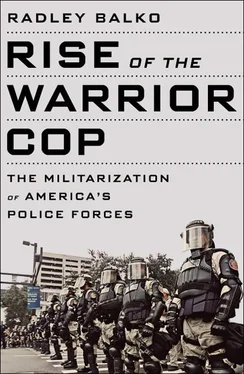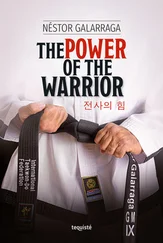This default militaristic response to protest of overkill was then given an extended national stage during the Occupy protests of 2011. In the most infamous incident, now forever captured in countless Internet memes and mashups, Lt. John Pike of the University of California–Davis campus police casually hosed down a peaceful group of protesters with a pepper-spray canister. But that was far from the only incident. Police across the country met protesters in riot gear, once again anticipating—and in too many instances seemingly even craving—confrontation. In Oakland, the skull of Iraq War veteran Scott Olsen was fractured by a tear-gas canister that the police had fired into the crowd. 91In New York, NYPD officer Anthony Bologna pepper-sprayed a group of helpless protesters who had been penned in by police fencing. 92
One thing the Occupy crackdowns did seem to do was focus renewed attention on police tactics and police militarization. Big-picture stories about the Pentagon buildup, Department of Homeland Security (DHS) funding for antiterror gear, and the proliferation of SWAT teams started streaming out of media outlets, giving the militarization issue the most coverage it had received since Kraska’s studies came out in the late 1990s. Part of that was due to social media. The ubiquity of smart phones and the viral capacity of Twitter, Facebook, Tumblr, and blogs were already bringing unprecedented accountability to police misconduct and government oppression, be it a Baltimore cop screaming obscenities at a kid on a skateboard, a transit cop in Oakland shooting a man who lay handcuffed on his stomach, or government paramilitaries in Iran gunning down a young woman in cold blood during Arab Spring democracy protests. But the Occupiers, who tended to be young, white, and middle- to upper-middle-class, knew social media like few other demographics. They knew how to live-stream video directly to the Internet. They all had smart phones, so police couldn’t suppress incriminating video by confiscating one or two or ten phones—someone was bound to have video of not only the original incident but also of police trying to confiscate phones to cover it up.
The political reaction to the Occupy crackdowns was interesting to watch. In the 1990s, it had been the right wing—particularly the far right—that was up in arms over police militarization. Recall the outrage on the right over Waco, Ruby Ridge, and the raid to seize Elián González. The left had largely either remained silent or even defended the government’s tactics in those cases. But the right-wing diatribes against jackbooted thugs and federal storm-troopers all died down once the Clinton administration left office, and they were virtually nonexistent after September 11, 2001. By the time cops started cracking heads at the Occupy protests, some conservatives were downright gleeful. The militarization of federal law enforcement certainly didn’t stop, but the 9/11 attacks and a friendly administration seemed to quell the conservatives’ concerns. So long as law enforcement was targeting hippie protesters, undocumented immigrants, suspected drug offenders, and alleged terrorist sympathizers, they were back to being heroes.
Steven Greenhut, a conservative-leaning columnist for the Orange County Register and editor of the investigative journalism site CalWatchdog, was dismayed by the right’s reaction. “What’s really disgusting is the natural instinct of so many conservatives to stick up for the police,” Greenhut wrote. “They don’t like the Occupy protesters, so they willingly back brutality against them, without considering the possibility that conservatives at some point might be on the receiving end of this aggression.” 93
Unfortunately, consistent voices like Greenhut’s have been rare. Partisan reaction to aggressive police actions against opponents tends to fall somewhere between indifference and schadenfreude.
After the December 2012 shooting massacre in Newtown, Connecticut put the issue of gun control back into the political discourse, some progressives again dredged up the right’s criticism of the ATF in the early 1990s. In one lengthy segment, MSNBC host Rachel Maddow aired old footage from Waco and Ruby Ridge while making some tenuous connections between gun rights politicians and activists and Weaver, McVeigh, and Koresh. She referred to a “conspiracy-driven corner of the gun world’s paranoia about federal agents,” without paying much heed to the fact that the ATF was inflicting the same sort of abuse on suspected gun offenders that Maddow herself has decried when used against suspected undocumented immigrants or Occupy protesters. More tellingly, Maddow added that there’s nothing wrong with wanting to give more power to the ATF based only on the politics of the people opposed to doing so . “Sometimes the character of the opposition defines why something ought to be the most politically viable thing in the world,” she said.
But even before Newtown, progressives have been advocating for the use of more government force against political factions they find unsavory. In 2009 the Department of Homeland Security issued a controversial report on what the author—DHS analyst Daryl Johnson—called a resurgence of right-wing extremism and the threat it posed to domestic security. The report was widely criticized on the right and was eventually criticized and revoked by DHS secretary Janet Napolitano. But after a spate of mass killings in the following years by assailants with political views that in some cases could loosely be characterized as right-wing, Johnson became something of a progressive hero. Most of the incidents involved clearly mentally ill attackers whose politics were all over the place. Even Johnson acknowledged that the incident most in line with his thesis—the massacre at a Sikh Temple in Oak Creek, Wisconsin, by a white supremacist named Wade Michael Page—was the work of a “lone wolf” attacker and likely would not have been prevented by the recommendations in his report.
Still, he was celebrated on the left. The progressive advocacy group Media Matters declared him “vindicated.” Similar sentiment popped up on progressive outlets like ThinkProgress, Salon, Rachel Maddow’s MSNBC blog, and Democracy Now .
In truth, attacks by groups on the fringes of the right wing have actually dropped in recent years, despite some claims that they’ve increased in response to the election of a black president. Attacks from groups on the fringes of the left wing are in decline too, as are alleged attempted terrorist attacks by fringe Muslim groups. 94
In a 2012 interview with the Idaho Spokesman Review, Johnson showed why it may not have been such a great idea for progressives to embrace him simply because he wanted to shut down opinions they found distasteful. Johnson was interviewed for an article on the twentieth anniversary of the Ruby Ridge fiasco, and he took one step further Rachel Maddow’s idea of supporting government force simply because you don’t like the factions opposing it. Johnson in fact suggested that merely having concerns about police militarization is a worry only borne by extremists. In fact, he appeared to have suggested that even recognizing that militarization is happening is an indication of fringe extremism.
“For American extremists, the siege at Ruby Ridge symbolizes the ‘militarized police state,’” said Johnson. The US government, through its Department of Homeland Security in particular, he said, “has unintentionally fostered, and even solidified, Orwellian conspiracies concerning an overzealous, oppressive federal government and its perceived willingness to kill to ensure citizen compliance…. In the minds of modern-day extremists, [Homeland Security] has enhanced the lethal capability of many underfunded, small-town police forces through its grant programs.” Using federal grants, state and local law enforcement agencies have been able to buy expensive equipment and training that are “commonly associated with the military,” he said, adding that “extremists view such a security buildup as a continuation of the Ruby Ridge legacy.” That legacy is a continuing drumbeat for extremists and white supremacists who recruit with the message of “big government versus the little guy” and “the government set me up.” These extremist ideas continue as messages and even recruiting themes among various radical groups in the United States, Johnson said. 95
Читать дальше












